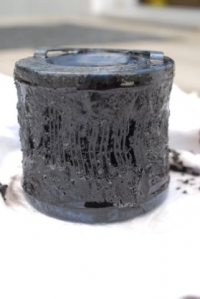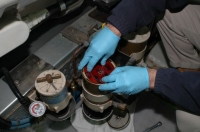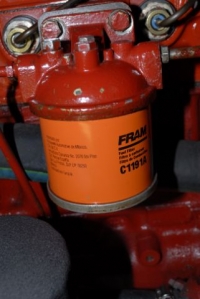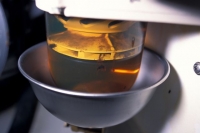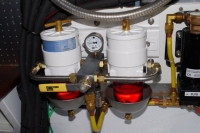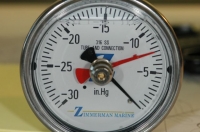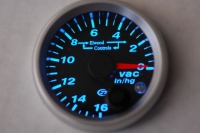Hello Steve,
I have a question, perhaps for your blog.
I have a Sabreline 36 Sedan with twin 6LYA-STP Yanmar 370hp engines.
The on engine filters are standard Yanmar. I have Racor 900MA turbine primary filters. I currently use 2 micron elements and have a pressure drop of 2-3 in Hg across the Racors at Wide open throttle. My mechanic says that I should only be using 10 or even 30 micron filters in the Racors and that by using the 2 micron ones, I am damaging my engine fuel lift pump and perhaps the injector pump. Is he correct? I maintain that the filters are rated for my engine’s flow (about 66 gal per hour max) and as long as the pressure drop across them is less than 15 inches of mercury and I can reach rated rpm (3300) at wide open throttle (WOT), I am ok. Is there any way to tell if the lift pump or the injector pump is performing normally or if they have been damaged?
Thanks
Mike Long
Selkie
Mike:
This is a great question. The 2 vs. 10/30 micron primary filter element debate is one that has raged for several years now and I suspect the end is nowhere in sight, and it applies to all diesel engines, from 10 hp sail auxiliaries to engines like yours. There’s good reason for the confusion. Many folks prefer to use a 2 micron filter because they don’t want to deal with the on-engine, primary filter, and I can’t say I blame them. This filter is often difficult to change without introducing air into the system, it’s usually expensive and sometimes difficult to access. Putting the Yanmar mechanic’s advice aside for the moment, I’ll come back to it, using a 2 micron element in the primary filter effectively reduces the area of the filter media by at least half, little if any dirt is making its way to the second filter, so it’s not being spread out over the two elements. This means, if you encounter gross contamination, you have that much less filter media with which to capture it. Additionally, sequential filtration is scientifically proven to be more effective than single stage, fine micron filtration, but you don’t have take my word for this, it’s SOP for most engine manufacturers, including Yanmar, as well as filter manufacturers such as Racor. Additionally, this approach is also used by the semi-conductor and pharmaceuticals industries for obtaining exceptionally clean water, a necessary ingredient for their processes. I detailed this philosophy in an article in PassageMaker about two years ago.
Now, back to what your mechanic said. Technically, he’s right in that this is Yanmar’s advice, however, I don’t necessarily agree with Yanmar’s reasoning as to why they recommend 10 or 30 micron primary filter elements. Indeed, chronically high vacuum on the intake side of the lift pump will cause diaphragm pumps to wear out more quickly, however, this would occur regardless of whether the element was 2 or 30 microns, the vacuum is the culprit not the micron rating. Their logic, however, is, I presume, that a 2 micron element will clog more quickly, which will lead to higher vacuum (anything over about 7 in. of mercury is cause for concern) and thus pump damage. Contrary to popular belief, a clean 2 micron element presents no greater resistance or vacuum than a clean 10 micron element (this is based on my personal experience and is confirmed by the folks at Parker/Racor). Just to be clear, If the lift pump is experiencing high fuel vacuum it’s possible that its output will be hindered, which could lead to fuel starvation at the injection pump. And, because the fuel is the lubrication within the injection pump, this in turn could lead to injection pump damage.
So, in the end, I agree with your mechanic and Yanmar, just not for the same reasons. If the vacuum is low, regardless of the element’s micron rating, then the pump will not be damaged. I’m not suggesting you violate their instructions, that may be grounds for denial of warranty coverage, but that really doesn’t matter because I’m a firm believer in sequential filtration, which would call for the use of a 10 or 30 micron primary filter element, in keeping with the manufacturer’s guidelines. This, in combination with the on-engine filter supplied by the manufacturer (or a high quality equivalent) will provide you with just that, excellent sequential filtration.
If you don’t want to deal with service of the on-engine secondary filter, you could always add another in line Racor 900, after the existing primary Racor and before the on-engine lift pump and filter. This new filter would become your secondary and the on-engine filter would become the tertiary filter (it could be changed seasonally, at your leisure). Technically, this would violate Yanmar guidelines, but the fuel would be very clean (you’d have two opportunities to capture dirt and water), and you wouldn’t have to deal with the on-engine filter element. If the vacuum experienced by the lift pump remained low, within the spec’s for your engine, then it’s unlikely that any damage would ever occur. Remember, any severely clogged filter will cause a high vacuum scenario and possible pump damage.
It doesn’t sound as if you’ve done any damage to the pumps and the pressure drop across your filter sounds normal, although I wouldn’t wait until it reaches 15 in Hg before changing the elements. Finally, use indicating vacuum gauges (the kind with a drag needle that can be reset) and water sensors/alarms on all primary filters.
Replacing the element in a Racor Turbine series primary filter is straightforward.
On-engine secondary filters, on the other hand, particularly those of the, “sandwich” variety can be especially challenging to replace.
Primary filters are capable of capturing and holding a tramendous amount of debris and water.
Tandem filter arrangements offer the user the option of keeping a clean filter in ready reserve at all times.
Although the vacuum reading was in the teens, the engine served by this primary (10 micron) filter element continued to operate, which is indicative of just how valuable these filters are when it comes to capturing and holding debris and contamination.
Recording vacuum gauges such as the one shown here are valuable tools in that they record the highest vacuum experienced by the filter at any time until reset.
Electronic, “differential” vacuum gauges will indicate vacuum across the filter alone, providing a clear indication of the element’s condition.

